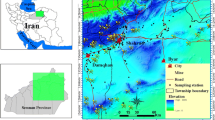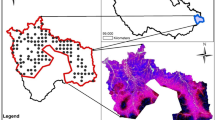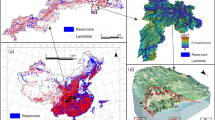Abstract
The significance of total polyaromatic hydrocarbons (TPAH) determination in assessing the carcinogenicity of environmental samples for measuring the level of environmental pollution cannot be overemphasized. Despite the environmental danger of TPAH, its laboratory quantification is laborious, which consumes appreciable time and other valuable resources. This research work develops a computational intelligence-based model for the first time, which directly estimates and quantifies the level of TPAH of any environmental solid samples using total petroleum hydrocarbons descriptor that can be easily determined experimentally. The hyperparameters of the developed support vector regression (SVR)-based model are optimized using manual search (MS) approach and genetic algorithm (GA) search approach with Gaussian and polynomial kernel functions. Experimental validation of the developed model was carried out using samples obtained from the marine sediments of Arabian Gulf Sea. The future generalization and predictive strength of the developed models were assessed using correlation coefficient (CC), root-mean-square error, mean absolute error and mean absolute percentage deviation (MAPD). GA-SVR-Gaussian performs better than MS-SVR and GA-SVR-poly with performance enhancement of 63.89% and 536.32%, respectively, on the basis of MAPD as a performance-measuring parameter, while MS-SVR model performs better than GA-SVR-poly with performance improvement of 288.25% using MAPD to evaluate the model performance. The estimation accuracy and generalization strength of the developed models indicate the potential of the models in measuring the level of environmental pollution of oil-spilled area without experimental stress, while experimental precision is preserved.








Similar content being viewed by others
References
Troisi GM, Bexton S, Robinson I (2006) Polyaromatic hydrocarbon and PAH metabolite burdens in oiled common guillemots (uria aalge) stranded on the East Coast of England (2001–2002). Environ Sci Technol 40:7938–7943. https://doi.org/10.1021/es0601787
Covino S, Čvančarová M, Muzikář M et al (2010) An efficient PAH-degrading Lentinus (Panus) tigrinus strain: effect of inoculum formulation and pollutant bioavailability in solid matrices. J Hazard Mater 183:669–676. https://doi.org/10.1016/j.jhazmat.2010.07.078
Ohnishi S, Kawanishi S (2002) Double base lesions of DNA by a metabolite of carcinogenic benzo[a]pyrene. Biochem Biophys Res Commun 290:778–782. https://doi.org/10.1006/bbrc.2001.6249
Zhu L, Caix J, Wang J (2005) PAHs in aquatic sediment in Hangzhou, China: analytical methods, pollution pattern, risk assessment and sources. J Environ Sci 17:748
Wang W-D, Huang Y-M, Shu W-Q, Cao J (2007) Multiwalled carbon nanotubes as adsorbents of solid-phase extraction for determination of polycyclic aromatic hydrocarbons in environmental waters coupled with high-performance liquid chromatography. J Chromatogr A 1173:27–36. https://doi.org/10.1016/j.chroma.2007.10.027
Ma J, Xiao R, Li J et al (2010) Determination of 16 polycyclic aromatic hydrocarbons in environmental water samples by solid-phase extraction using multi-walled carbon nanotubes as adsorbent coupled with gas chromatography–mass spectrometry. J Chromatogr A 1217:5462–5469. https://doi.org/10.1016/j.chroma.2010.06.060
García-Falcón MS, Cancho-Grande B, Simal-Gándara J (2004) Stirring bar sorptive extraction in the determination of PAHs in drinking waters. Water Res 38:1679–1684. https://doi.org/10.1016/j.watres.2003.12.034
Shariati-Feizabadi S, Yamini Y, Bahramifar N (2003) Headspace solvent microextraction and gas chromatographic determination of some polycyclic aromatic hydrocarbons in water samples. Anal Chim Acta 489:21–31. https://doi.org/10.1016/S0003-2670(03)00709-8
ATSDR (1999) Toxicological profile for total petroleum hydrocarbons (TPH). Agency Toxic Subst Dis Regist US Dep Heal Hum Serv 315
Analytical F, List SP (2014) Full analytical services price list. 1–30
Schreier CG, Walker WJ, Burns J, Wilkenfield R (1999) Total organic carbon as a screening method for petroleum hydrocarbons. Chemosphere 39:503–510
Akande KO, Owolabi TO, Olatunji SO, AbdulRaheem A (2017) A hybrid particle swarm optimization and support vector regression model for modelling permeability prediction of hydrocarbon reservoir. J Pet Sci Eng 150:43–53. https://doi.org/10.1016/j.petrol.2016.11.033
Kang F, Xu Q, Li J (2016) Slope reliability analysis using surrogate models via new support vector machines with swarm intelligence. Appl Math Model. https://doi.org/10.1016/j.apm.2016.01.050
Adeyemo HB et al (2019) Heliyon Hybrid chemometric approach for estimating the heat of detonation of aromatic energetic compounds. Heliyon 5(7):1–8
Sain SR, Vapnik VN (1996) The nature of statistical learning theory. Technometrics 38:409. https://doi.org/10.2307/1271324
Jalali-Heravi M (2008) Neural networks in analytical chemistry. Artif Neural Netw Methods Appl 458:78–118. https://doi.org/10.1007/978-1-60327-101-1_6
Cirovic DA (1997) Feed-forward artificial neural networks: applications to spectroscopy. Trac-Trends Anal Chem 16:148–155. https://doi.org/10.1016/S0165-9936(97)00007-1
Smits JRM, Schoenmakers P, Stehmann A et al (1993) Interpretation of infrared spectra with modular neural-network systems. Chemom Intell Lab Syst 18:27–39. https://doi.org/10.1016/0169-7439(93)80042-G
Owolabi TO, Gondal MA (2018) Development of hybrid extreme learning machine based chemo-metrics for precise quantitative analysis of LIBS spectra using internal reference pre-processing method. Anal Chim Acta 1030:33–41. https://doi.org/10.1016/j.aca.2018.05.029
Kang F, Li J, Zhao S, Wang Y (2019) Structural health monitoring of concrete dams using long-term air temperature for thermal effect simulation. Eng Struct 180:642–653. https://doi.org/10.1016/j.engstruct.2018.11.065
Owolabi TO, Akande KO, Olatunji SO (2016) Application of computational intelligence technique for estimating superconducting transition temperature of YBCO superconductors. Appl Soft Comput J 43:143–149. https://doi.org/10.1016/j.asoc.2016.02.005
Owolabi TO, Faiz M, Olatunji SO, Idris Popoola K (2016) Computational intelligence method of determining the energy band gap of doped ZnO semiconductor. Mater Des 101:277–284. https://doi.org/10.1016/j.matdes.2016.03.116
Owolabi TO (2019) Modeling the magnetocaloric effect of manganite using hybrid genetic and support vector regression algorithms. Phys Lett Sect A Gen At Solid State Phys 383:1782–1790. https://doi.org/10.1016/j.physleta.2019.02.036
Adewumi AA, Owolabi TO, Alade IO, Olatunji SO (2016) Estimation of physical, mechanical and hydrological properties of permeable concrete using computational intelligence approach. Appl Soft Comput 42:342–350. https://doi.org/10.1016/j.asoc.2016.02.009
Riahi S, Pourbasheer E, Ganjali MR, Norouzi P (2009) Investigation of different linear and nonlinear chemometric methods for modeling of retention index of essential oil components: concerns to support vector machine. J Hazard Mater 166:853–859. https://doi.org/10.1016/j.jhazmat.2008.11.097
Gupta SM (2007) Support vector machines based modelling of concrete strength. World Acad Sci Eng Technol 36:305–311
Parveen N, Zaidi S, Danish M (2017) Support vector regression prediction and analysis of the copper (II) biosorption efficiency. Indian Chem Eng 59:295–311. https://doi.org/10.1080/00194506.2016.1270778
Parveen N, Zaidi S, Danish M (2017) Development of SVR-based model and comparative analysis with MLR and ANN models for predicting the sorption capacity of Cr(VI). Process Saf Environ Prot 107:428–437. https://doi.org/10.1016/j.psep.2017.03.007
Owolabi TO, Akande KO, Olatunji SO (2016) Estimation of average surface energies of transition metal nitrides using computational intelligence technique. Soft Comput. https://doi.org/10.1016/j.asoc.2015.03.009
Holland JH (1992) Genetic algorithms. Sci Am. https://doi.org/10.1038/scientificamerican0792-66
Owolabi TO (2019) Determination of the velocity of detonation of primary explosives using genetically optimized support vector regression. Propellants Explos Pyrotech 44:1282–1292. https://doi.org/10.1002/prep.201900077
Abdel Gawad EA, Al Azab M, Lotfy MM (2008) Assessment of organic pollutants in coastal sediments, UAE. Environ Geol 54:1091–1102. https://doi.org/10.1007/s00254-007-0880-x
Boukouvalas A, Cornford D, Stehlík M (2014) Optimal design for correlated processes with input-dependent noise. Comput Stat Data Anal 71:1088–1102. https://doi.org/10.1016/j.csda.2013.09.024
Owolabi TO, Akande KO, Olatunji SO et al (2017) Incorporation of GSA in SBLLM-based neural network for enhanced estimation of magnetic ordering temperature of manganite. J Intell Fuzzy Syst 33:1225–1233. https://doi.org/10.3233/JIFS-17057
Owolabi TO, Akande KO, Olatunji SO (2014) Estimation of superconducting transition temperature TC for superconductors of the doped MgB2 system from the crystal lattice parameters using support vector regression. J Supercond Nov Magn 28:75–81. https://doi.org/10.1007/s10948-014-2891-7
Acknowledgements
The research was also conducted under RU grants ST028-2019 and 17AET-RP44C under corresponding author Dr. Zaira Zaman Chowdhury as principal investigator from the University of Malaya, Malaysia.
Author information
Authors and Affiliations
Corresponding author
Ethics declarations
Conflict of interest
All authors declared that there is no conflict of interest for publishing this paper.
Additional information
Publisher's Note
Springer Nature remains neutral with regard to jurisdictional claims in published maps and institutional affiliations.
Rights and permissions
About this article
Cite this article
Akinpelu, A.A., Ali, M.E., Owolabi, T.O. et al. A support vector regression model for the prediction of total polyaromatic hydrocarbons in soil: an artificial intelligent system for mapping environmental pollution. Neural Comput & Applic 32, 14899–14908 (2020). https://doi.org/10.1007/s00521-020-04845-3
Received:
Accepted:
Published:
Issue Date:
DOI: https://doi.org/10.1007/s00521-020-04845-3




